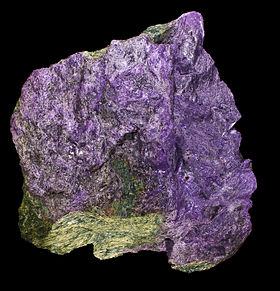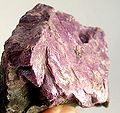- Stichtite
-
Stichtite
Catégorie V : carbonates et nitrates[1]
Stichtite - Toptoype Stichtite Hill, Dundas Australie Général Classe de Strunz 5.DA.50 Formule brute Mg6Cr2CO3(OH)16,4H2O Identification Masse formulaire[2] 654,0097 ± 0,0142 uma
C 1,84 %, H 3,7 %, Cr 15,9 %, Mg 22,3 %, O 56,27 %,Couleur violet lilas, rose Classe cristalline et groupe d'espace ditrigonale-scalénoédrique ; R -3m Système cristallin trigonal Réseau de Bravais rhomboédrique (hR) Clivage parfait à {0001} Cassure écailleuse Habitus massif, folié, lamellaire, fibreux, écaillé, micacé, tabulaire, grenu Échelle de Mohs 1,5-2 Trait blanc, violet pâle Éclat nacré, vitreux, cireux, gras Propriétés optiques Indice de réfraction w=1.516, e=1.542 Pléochroïsme faible: O= rose foncé à lilas E= rose clair à lilas Biréfringence Uniaxial(+); 0.0260 Fluorescence ultraviolet aucune Transparence transparent à translucide Propriétés chimiques Densité 2,11-2,16 Propriétés physiques Magnétisme aucun Radioactivité aucune Unités du SI & CNTP, sauf indication contraire. La stichtite est une espèce minérale du groupe des carbonates et du sous-groupe des carbonates hydratés de formule Mg6Cr2CO3(OH)16,4H2O, présentant des traces de fer.
Sommaire
Inventeur et étymologie
Décrite par le minéralogiste William Frederick Petterd (1849 - 1910) [3]qui donna le nom de stichtite à ce minéral en 1910, en l'honneur de l'australien Robert C. Sticht (1857 - 1922) directeur de la Mount Lyell Mining and Railway Company en Tasmanie.
Topotype
- Mine Adélaïde, Stichtite Hill, Dundas, Tasmanie, Australie
- Les échantillons de référence sont déposés à l’École nationale supérieure des mines de Paris.
Synonymie
- Chrom-Brugnatellite (Hezner 1912) [4]
Caractéristiques physico-chimiques
Variété
- Bouazzerite (Calleres 1942) : Stichtite riche en fer décrite par Calleres dans les serpentines de Bou Azzer au Maroc qui a inspiré le nom[5].
Cristallochimie
- Dimorphe de la barbertonite.
- La stichtite fait partie du groupe de l'hydrotalcite groupe de carbonates isostructurels de formule générique Mg6R3+2(OH)16CO2.4H2O ou R+3 peut être Al, Cr, ou Fe.
Groupe de l'hydrotalcite
- Desautelsite Mg6Mn2(CO3)(OH)16•4(H2O) R 3m ou R 3m Trig
- Droninoite Ni3FeCl(OH)8•2H2O R 3m, R 3m ou R 32 Trig
- Hydrotalcite Mg6Al2(CO3)(OH)16•4(H2O) R 3m 3 2/m
- Pyroaurite Mg6Fe2(CO3)(OH)16•4(H2O) R 3m 3 2/m
- Stichtite Mg6Cr2(CO3)(OH)16•4(H2O) R 3m 3 2/m
Cristallographie
- Paramètres de la maille conventionnelle: a=6,18 Å, c=46,38 Å, Z=3, V=1 534,05 Å3
- Densité calculée= 2.12
Propriétés physiques
- Habitus
- la stichtite forme le plus souvent des masses compactes, ou des agrégats lamellaires ou fibreux. Les lamelles de stichtite sont onctueuses au toucher et sont flexibles, mais non élastiques.
Gîtes et gisements
Gîtologie et minéraux associés
Gîtologie : la stichtite a une origine métamorphique. Elle se trouve associée à la chromite dans les serpentines (roches métamorphiques riches en magnésium et en fer).
- Minéraux associés
- antigorite, barbertonite, chromite,serpentine.
Gisements producteurs de spécimens remarquables
- Afrique du Sud
- Kaapsche Hoop, Barberton District, Mpumalanga Province, Transvaal[6]
- Australie
- Mine Adélaïde, Stichtite Hill, Dundas, Tasmanie[7]
- Canada
- Marbridge Mine, La Motte, Abitibi RCM, Abitibi-Témiscamingue, Québec[8]
- Iran
- Maroc
- Bou Azzer, Province de Ouarzazate[9]
Galerie
Notes et références
- La classification des minéraux choisie est celle de Strunz.
- Masse molaire calculée d’après Atomic weights of the elements 2007 sur www.chem.qmul.ac.uk
- Petterd (1910), Catal. Minerals of Tasmania, 3rd ed., p. 167.
- Hezner (1912), Centralblatt für Mineralogie, Geologie und Paleontologie, Stuttgart: 569.
- Calleres, S. (1942): "Stichtite collected in the serpentinite massif of Bou Azzer at Bou Oufroh.: Bulletin de la Société Française de Minéralogie et Cristallographie: 65: 135-136.
- Hall, A.L. (1922): On a new occurrence of stichtite from the Barberton district. Transactions of the Geological Society of South Africa 24, 182-187.
- Bottrill, R. S. and Graham, I.T., Stichtite from Western Tasmania. Australian Journal of Mineralogy, 12, 101-107.
- Sabina, A.P. (2003) GSC Misc. Report 77,125-127
- Favreau, G. and Dietrich, J. E. (2006). Die Mineralien von Bou Azzer. Lapis 31(7/8), 27-68
- Mineralogical Magazine, volume 039, pp. 377(1973)
- Le Grand Atlas Roches et Minéraux, Éditions Atlas, 2005, pp.385-386
- Minéraux et Pierres précieuses, Éditions Atlas, 1979, pp.204
- La Grande Encyclopédie des Minéraux, Éditions Gründ, 1986, pp.48
- Portail des minéraux et roches
- Portail de la chimie
Catégories :- Chrome (minéral)
- Magnésium (minéral)
- Carbonate (minéral)
- Polymorphisme
Wikimedia Foundation. 2010.



